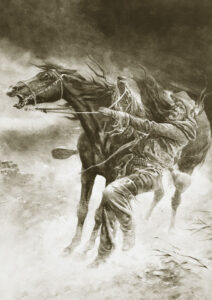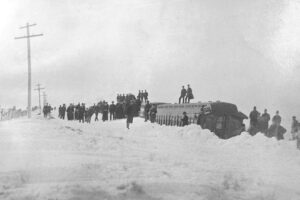The blizzard of December 1885 and January 1886 was probably the most destructive to life and property of any storm that ever swept over Kansas. This storm raged from the Rocky Mountains to the Missouri River. It started in the latter part of December 1885, and an unbroken blanket of snow extended from Williams, New Mexico, to Kansas City, Missouri. Railroad traffic on the plains was practically suspended.
Two great blizzards hit western Kansas the first week of January 1886. The first began on January 1 at about noon in Dodge City and continued until the early morning hours of January 3. Thirty-six continuous hours of blizzard conditions were likely experienced in and around Dodge City, dropping seven and a half inches of snow, with wind speeds averaging 20 to 30 mph from the north to northwest. The lowest temperature was 12 °F on the 3rd.
There was no advance warning for the cold wave, and a second blizzard hit on the night of January 6. The Chief Signal Office sent a notification for a cold wave. However, because of the conditions, the telegraph office in Dodge City did not receive it until the storm ended. It was accompanied by Arctic air that sent temperatures plummeting to well below zero. Despite less snowfall and a bit shorter duration, it had more severe and had greater impacts. This blizzard exacerbated the problems that were spawned and the cleanup from the first storm and was responsible for more injury and death not only to huge populations of cattle but also to humans.
The wind combined with the brutally cold air accompanied the blizzard of January 7, some of the coldest air Dodge City has ever seen in conjunction with accumulating snow and north winds. There was little time between storms for snow melt; therefore, snow and blowing/drifting snow with the second blizzard was far more severe than it would have been without any pre-existing snowpack. One of the coldest periods on record, the temperature did not rise above 10°F at Dodge City until the 11th. The coldest temperature was 16°F below zero on the 8th.
How many more cattle were lost across Kansas during this time is unclear. It was estimated that 75-80 percent of cattle had been killed in some counties. What is known is that this was the worst natural disaster for the entire state of Kansas.
A livestock fence was north of the Union Pacific Railroad tracks in northern Kansas. Cattle would drift south with the storms and eventually wound up dying of starvation and exhaustion along the fence. It was said that a man could walk along the fence over bones all the way to eastern Colorado. South of the railroad, cattle would march south until they ended up falling into ravines or small canyons. Other cattle would follow and eventually would wind up on top of the cattle in the ravine. The cattle died by smothering, starvation, or freezing.
There was also a newspaper account of cattle trains headed east across Kansas. The trains were rushed to Dodge City, which was a feeding station. Less than 25% of the unloaded cattle had survived the next morning. Cattle also died trying to cross the Arkansas River, creeks, and water holes. A man who came into Dodge City from his ranch told of seeing cattle standing on their feet, frozen!
The blizzard and Arctic air mass also affected the southern plains. Cattle had drifted several hundred miles south into northern New Mexico. Dead carcasses, dead antelope, and even wolves were seen on the plains.
Another newspaper account told the story of a rancher who was offered $25,000 for his cattle before the storms hit. After the blizzards, he sold the remnants of his cattle for $500. There was a ranch in southwestern Kansas with 5,500 cattle before the storm, and only 500 survived. Not even the hides could be saved from the cattle that perished. The blizzards resulted in the most unprecedented loss of livestock ever experienced on the plains.
The Blizzards of 1886 also took a heavy toll on human life. Estimates were that as many as 30 people died in western Kansas from the blizzards. There was also another account of 35 people dying in Thomas County. As many as 50 to 100 people had died across the entire state of Kansas. Townspeople fared well as compared to settlers out in the prairie. There were several instances where people were found frozen to death in their dugouts and shanties. Other people were found on the prairie dead.
There are several heartbreaking stories of how some of the people died. Two young ladies froze to death near Minneola in Clark County. They were walking, trying to reach their brothers’ house for shelter from the blizzard. They had left their house, which was filling up with snow, with their mother. In the end, all three were located the next morning huddled together. The two young women died, but their mother was still alive with badly frozen feet. Another story involved a homesteader and his team of two horses caught out in the blizzard in northwest Kansas. They froze to death within 50 feet of the man’s dugout. Outside of Oberlin, a farmer with his wife and six children was found frozen to death. Jackrabbits and birds of every species were found frozen across the prairie. Snow depths were not deep, but some drifts were up to ten feet high.
Losses of life during this blizzard were reported from Clark, Ellis, Ellsworth, Finney, Ford, and Wallace Counties, together with a few casualties from the southwestern part of the state. This loss of life is accounted for to some extent by the fact that thousands of claim holders settled in western Kansas in 1885, with few exceptions having barely enough to develop a homestead. As a rule, their houses were mere shells and proved inadequate for the rigorous winter.
All the railroads in Kansas were utterly paralyzed. Trains were stalled, and it wasn’t easy to clear the tracks. The temperature during January ranged from 12° below zero in Atchison to 25° below in Junction City and 18° below in Dodge City. The precipitation was chiefly sleet all over the southwestern part of the state, leaving the ground covered with ice. A big cut on the Union Pacific Railroad near Salina was completely covered with snow, and it required the combined efforts of all section men on the road between Lawrence and Brookville for nearly 16 hours with picks and shovels to open it for traffic. This cut was about 20 feet deep and a quarter of a mile long, and eleven locomotives were employed in “bucking” the snow, but they all became stalled and had to be dug out. Many points on the railroads were a week without mail from the outside world, and cattle losses from some sections were reported from three to twenty-five percent.
After the tracks were finally cleared, a passenger train was stopped in western Kansas by an obstruction ahead of it. Snow began to drift around the wheels, and it became stuck. The snow had drifted up to the windows of the train. Several days later, the wheels were frozen to the rail when the snow was removed. The rail cars had to be unbuckled and broken loose one at a time.
Other blizzards since January 1886 have been just as bad. However, after the Blizzard of 1886, the plains country changed. Changes were made in preparation for the winter months to help prevent livestock losses. First, ranchers put up more fences to keep the cattle from drifting onto the open prairie, and more provisions were made available for the livestock before the cold months. Farms and good farmhouses, fences, and well-traveled roads were built everywhere. The Weather Bureau made advances in better dissemination of storm warnings. Finally, the railroad companies acquired a modern rotary snowplow to help remove the deepest snowdrifts. Afterward, casualties from similar causes in later years were rare.
Compiled by Kathy Alexander/Legends of Kansas, September 2023.
Also See:
Sources:
Blackmar, Frank W.; Kansas: A Cyclopedia of State History, Vol I; Standard Publishing Company, Chicago, IL 1912.
National Weather Service




